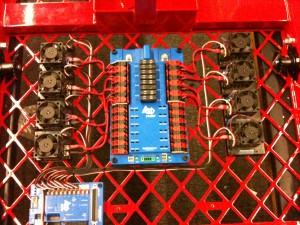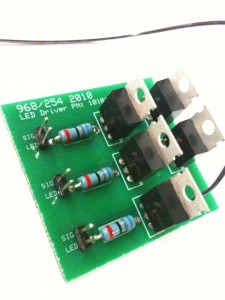2010 Teams 254/968 Collaborative Build Blog Blog
SVR
We won. Woo!
We brought home the entire super structure/arm as part of our withholding allowance. We will be working on the kicker and tying to make it more consistent. There were some issues at SVR where a “Middle” distance kick would just kind of putt the ball forward. You can see that happen in this video at 1:50ish.
We will also be working on refining the arm, and making it hang faster. Yay for continuous improvement.
Possible causes for kicker inconsistencies:
1. Balls being grabbed too hard – When ramming balls into the wall, it is possible that the ball is being grapsed so hard that the kicker has trouble ejecting it from its grasp. After initial auton testing on Thursday, the code was changed to remove the slight roller pause during kicking, which likely was previously releasing the tight grasp on the ball, giving a more repeatable kick. When testing on the practice field, we were gingerly placing the ball into the roller before kicking. This differed greatly from on field interaction, as more often than not the ball was rammed into the wall or bump, forcing it further into the roller and causing it to grab very hard.
2. Who knows? I will put money on cause #1 – TC
More Autonomous Development
Here is the idea for SVR auto modes:
1) Far Zone – Shoot 3 Balls – Long Kicks
2) Far Zone – Shoot 3 Balls – Bounce kicks in middle zone (more accurate shots, but more chance of ball hitting partner)
3) Middle Zone – Shoot 2 Balls – Start touching tower and go in at angle
4) Close Zone – Shoot 1 Ball – Start touching tower and go in at angle
Number 2 is working as of tonight. It can consistently hit 2/3 shots, but with a bigger field I imagine this will be better.
Bumpers, and practice/development
Today the bumpers for team 254 were completed and are currently en-route. The embroidery looks great. The bumper tubes may need to be milled slightly in width, to account for thicker-than-expected fabric. This would allow the attachment pins to insert into the robot further, if they do not quite reach. A couple members from team 968 will be spending the weekend at the 254 lab, to install revised components, practice driving, and develop code.
Beginning Competition Preparations
Preparations for Competition next week have begin. Numerous teams of students have been working hard to complete the Competition Robot’s superstructure, which will be carried in as part of the withholding allowance. Several students worked to complete a bill of materials and plan out the packing of the crate from Silicon Valley to Las Vegas. Batteries have been ordered.
Autonomous Development – Part 1
(There was a video here that has sadly been lost in the archives.)
It’s a start…
Kicker Testing
Kicker testing continued today, after a series of mishaps with the arm last night. We found that we could shoot well from midfield and poorly from either extreme with the current configuration.
We milled the kicker plate down by 1/8″ from it’s already shortened state to make it a total of 5/16″ shorter than designed. With the new length we can now shoot extremely repeatably from midfield, well from anywhere in the far zone, and well from the back third of the home zone.
Videos below demonstrate the kicker at various positions on the field. Any variations in kick distance are due to varying air pressure of the balls.
(There was a video here that has sadly been lost in the archives.)
(There was a video here that has sadly been lost in the archives.)
(There was a video here that has sadly been lost in the archives.)
(There was a video here that has sadly been lost in the archives.)
(There was a video here that has sadly been lost in the archives.)
(There was a video here that has sadly been lost in the archives.)
Position 0: 13 Encoder Counts
Position 1: 16 Counts
Position 2: 18 Counts
Position 3: 23 Counts
Robot Progress
We field tested the final design of the Gyroscope assembly at the Proving Grounds. During this test, we also tested the robot “Drive Straight” software routine. This works like money.
Earlier in the day, students and mentors joined the superstructure to the drive base. We then calibrated our kicker system. We still need to add the 3M self fusing electrical tape to the ball roller assembly and properly tension the kicker.
We’re far behind 254, but after today, we’re now in better shape.
Bumper Progress
Foam pool noodles have been affixed to all 8 bumper assemblies. The fabric for all the assemblies has been cut, and sewn in the corners. The fabric is currently at the embroidery shop. Currently, we expect to receive the 254 fabric pieces back on Saturday 3/6. They will then be adjusted for fitment, and permanently assembled to the bumpers. The 968 bumper assemblies will follow suit next week.
Roller Improvements
Today, several improvements on the roller assembly were completed. The holes on both roller plates were hex broached to accommodate a new lower roller. A design flaw in the previous design allowed the lower roller to free itself and spin in a direction that did not allow the robot to properly hold the ball. A new shaft was completed. Additional shafts for the remaining robots will be manufactured in coming days, once the design is tested.
Work continued to tune the kicker positions for accurate ball scoring. With our 128 count encoder on the kicker, it zeros itself on every kick and is able to winch back accurately each time. The trampoline springs provide extremely repeatable force (as long as ball pressure is consistent). We have been working to tune the number of encoder counts which the kicker must winch back for optimum scoring from any point on the field.
New Plates!
Today, the second prototype plates to replace the hard stop plates were completed and installed. These plates included mounting provisions for attaching three trampoline springs to power the kicker and allow the arm to stow properly, two features not included in the initial prototype. Four full sets of these plates will be manufactured as soon as the material arrives and will be anodized for final robot use.
Software and Hardware Testing/Progress
Today in the Systems Engineering and Integration(SEaI) division, students and mentors tested the gyroscope assembly (PN: 1010167) and integrated the part into our system. SEaI also began developing software routines for a closed loop control of the robot when there is no steering input. Tomorrow, SEaI will also begin development on the autonomous routines/controller for the robot. SEaI hopes to replicate the 2008 968 autonomous controller with major changes, which, makes the system more efficient and elegant.
At DAVECO, David and his associates assembled the bumper assembly minus the Cordura fabric. Mock-ups were developed to visualize the stitch patterns required to have bumper fabric with no folds. The contractor will continue manufacturing of the bumpers for the next few days.
Stay tuned.
Progress
Today, the team worked to optimize the kicker and arm. The surgical tubing on the kicker was replaced with trampoline springs, to make it more easy to get a repeatable and known force. A gas spring was installed on the first stage of the arm to aid in arm deployment. Finally, limit switches were added in the pole grabber and on the arm to completely automate the lifting.
Now, thanks to help from the software team, once the arm deployed switch is flipped, the arm will deploy automatically. While the switch is still up, the robot will lift immediately once it is locked onto the bar and will stop when it has reached its final lifted position. This automation is an improvement in speed over what human drivers were able to obtain, due to prior uncertainty about whether or not the robot was locked on the pole.
Design Progress
Today, the design team worked to design the polycarbonate side shields for the robots. Due to weight issues, we will probably not be able to implement all of the polycarbonate shields on the robot.
The team also designed the cutouts which will be made on the bumper spacer tubes. The cutouts reduce the weight of the tube by over 50% by pocketing the side faces to keep proper bumper spacing and facing down the top and bottom faces from 1/8″ to 1/16″.
Score to Hang – 10 seconds
With mentors as drivers, no less…
(There was a video here that has sadly been lost in the archives.)
Design & Manufacturing Progress
Today, the design team completed the design on replacements for the Hard Stop Mounting Plates. The replacements will extend the plate back to support the PTO shaft directly above the gearboxes after said shaft was identified as a potential point of failure. The plates also include provisions for a new bar to mount the surgical tubing for the kicker on.
Later on in the day, the manufacturing team built two prototypes of aforementioned plates which will be installed and tested tomorrow.
Modified Kicker
Today the kicker plate was shortened. The shorter plate contacts the ball higher up on the ball, giving it a flatter trajectory. A rope was added as a hard stop, which prevents the kicker from contacting the roller system.
(There was a video here that has sadly been lost in the archives.)
(There was a video here that has sadly been lost in the archives.)
(There was a video here that has sadly been lost in the archives.)
Robot Shipped
As of 2:00 PM today the robot was delivered to drayage and confirmation of shipment has been sent to FIRST.
Robot Crated
The Robot Was Crated Tonight. Final Weights of Shipped Components:
- Drivebase (without cRio) – 52 lbs
- Arm – 19 lbs
The superstructure was withheld as part of the 65 lb withholding allowance.
Kickin Balls
(There was a video here that has sadly been lost in the archives.)
Feb 19 Progress
Today, we (almost) finished assembling the drivetrain and kicker winch gearboxes. We also made further progress on the bumper fabrication.
Here’s some photos to pass your time.



